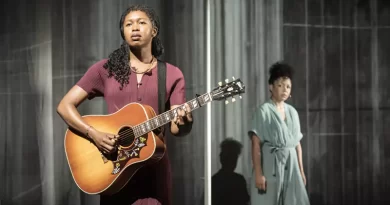“Look Back in Anger” at Almeida Theatre
Jeremy Malies in North London
6 October 2024
John Osborne’s 1956 play Look Back in Anger hasn’t been seen in London for 25 years. It’s often divisive, with the misogyny (call it chauvinism at best) proving a cause for concern.

Billy Howle and Ellora Torchia.
Photo credit: Marc Brenner.
I’ve seen the play more recently (14 years ago in Edinburgh) where a youthful female critic caused an unexpected spat. She enraged readers by making the non-PC comment that the male lead wasn’t glamorous enough for it to be credible that both women should be in love with him! An immediate backlash from people of all genders and sexual orientations across social media must have persuaded her (quite rightly) that there are indeed some great causes left.
Atri Banerjee’s direction (he excelled recently in the markedly different context of Racine’s alexandrine metre) suffuses the whole piece with Fifties chic. It’s in the stage directions of course but sound designer Peter Rice has Jimmy (Billy Howle) play modal jazz offstage in his bedroom, just to underline that as a rebel he ignores harmonic convention in the same way that he enjoys disharmony with the two women in his life.
If I could ask John Osborne one thing about the play, I’d want to know how he envisaged this ferocious character running a sweet stall for a living. Just as it’s ludicrous that serial seducer Norman in Alan Ayckbourn’s The Norman Conquests should be a librarian, you would have to think that a nipper wanting two ounces of sherbet from Jimmy in this unnamed Midlands town might be terrified.
It’s not condoned of course but Banerjee’s treatment of the plot acknowledges (the theme is also present in Tennessee Williams’ handling of Stanley and Stella in Streetcar) that violence (coercion perhaps) can be a sexual accelerant in even settled relationships.
Ellora Torchia as Alison.
Photo credit: Marc Brenner.
Banerjee and the creative team (notably movement director Imogen Knight) vary the pace from Sunday afternoon sluggishness (almost of the Tony Hancock kind) to Jimmy and Alison (played by Ellora Torchia) using Naomi Dawson’s circular set as a pair of whirling dervishes. Their movements are occasionally balletic (the circular set helps) and you have to think that the unseen sexual congress is almost tantric which literally means “woven”.
“I haven’t any feelings for music or people …” says Howle as Jimmy. And he is certainly woven to nothing except his own whims and ego. There now comes a plot twist involving Alison’s friend, Helena, played by Morfydd Clark who has anchored the Almeida companion piece Roots by Arnold Wesker as the protagonist, Beatie. (The plays are presented in repertory as an “Angry and Young” season.)
Clark impresses as she moves from Beatie’s East Anglian participles and verb forms to the heightened RP of Helena, a successful upper-middle-class actress. Helena is regal with: “Why do you try so hard to be unpleasant?” (The fact that we have just seen Clark in another role, and her new character is an actress makes things a tad metatheatrical.)
As Alison’s colonel father, Deka Walmsley also goes (across the two plays) from lower to upper-middle class. An Anglo-Indian (in the sense of having been part of the final days of the Raj) the colonel is a pure Rattigan character, with Walmsley tapping into that mode. He brings a stillness and elegiac quality to his one scene. It’s a fallacy to say that Osborne consciously rebelled against the tradition that Rattigan created; the two men corresponded and the younger always acknowledged a debt to his senior.
Dawson’s sweeping design (all smooth geometrical shapes) gives us a double helping of ironing boards with a spectacular second entrance for Helena. It doesn’t quite rank as a coup de théâtre but produced intakes of breath on press day.
The pairing of these two plays underlines common themes such as characters worrying about the advent of the hydrogen bomb and a new social mobility producing romantic relationships across the class spectrum. It seems a sign of the times that Jimmy should be involved with a woman whose brother has been to Sandhurst. But seeing both plays in the same day, I never felt that any of the parallels were forced. And the programming is revealing. I can only quote Jimmy who, with his Johnsonian resonance, says: “I have never seen so many souls stripped to the waist.”
Playing Cliff, Jimmy’s Welsh buddy and flatmate, Iwan Davies (The Corn is Green) can use his resting accent. He is tactile with Alison which helps Banerjee with what I take to be his strategy of presenting the plot almost as a ballet or even physical theatre with performers remaining close and Torchia suggesting dance with much of her movement. Is some of the closeness and rough and tumble between Jimmy and Cliff homoerotic? What does Jimmy mean when he says, “I’m tired of being hetero …”? Of course this comes in a tongue-in-cheek song lyric he has written and may just mean “different” as in the Greek or an outlier.
If it’s true that there are (were) no great causes left, Billy Howle is the kind of primal force to persuade you that he might just be able to manufacture one, and in this production I truly get what Helena means when she describes him as looking like a Renaissance pope. Howle gives the impression that he has never had a tranquil moment.
It’s an impressive piece of programming by the Almeida. I’m glad this period piece is not being neglected and left in aspic. Even if some of the themes are unpalatable, Banerjee – who considers that what a director really works with is his actors’ raw energy – has combined with fellow director Diyan Zora (as well as overall artistic Rupert Goold) to serve up an extraordinary joint offering.










